Retail Dynamics in Australia: Departmental vs Discount Stores
VerifiedAdded on 2023/06/07
|13
|2544
|111
Report
AI Summary
This report examines the evolving retail landscape in Australia, focusing on departmental and discount stores. It explores the wheel of retailing and retail life cycle theories to understand market dynamics. The report identifies merchandise strategies employed by retail outlets and segments the market based on demographics, geography, psychographics, and behavior. It discusses the factors driving the evolution of retail, including mergers, diversification, and the rise of e-commerce. The report also provides insights into the future of retailing in Australia, anticipating a shift towards online shopping and the integration of robotics, while also acknowledging potential security challenges. This document is available on Desklib, a platform offering a wealth of study resources for students.
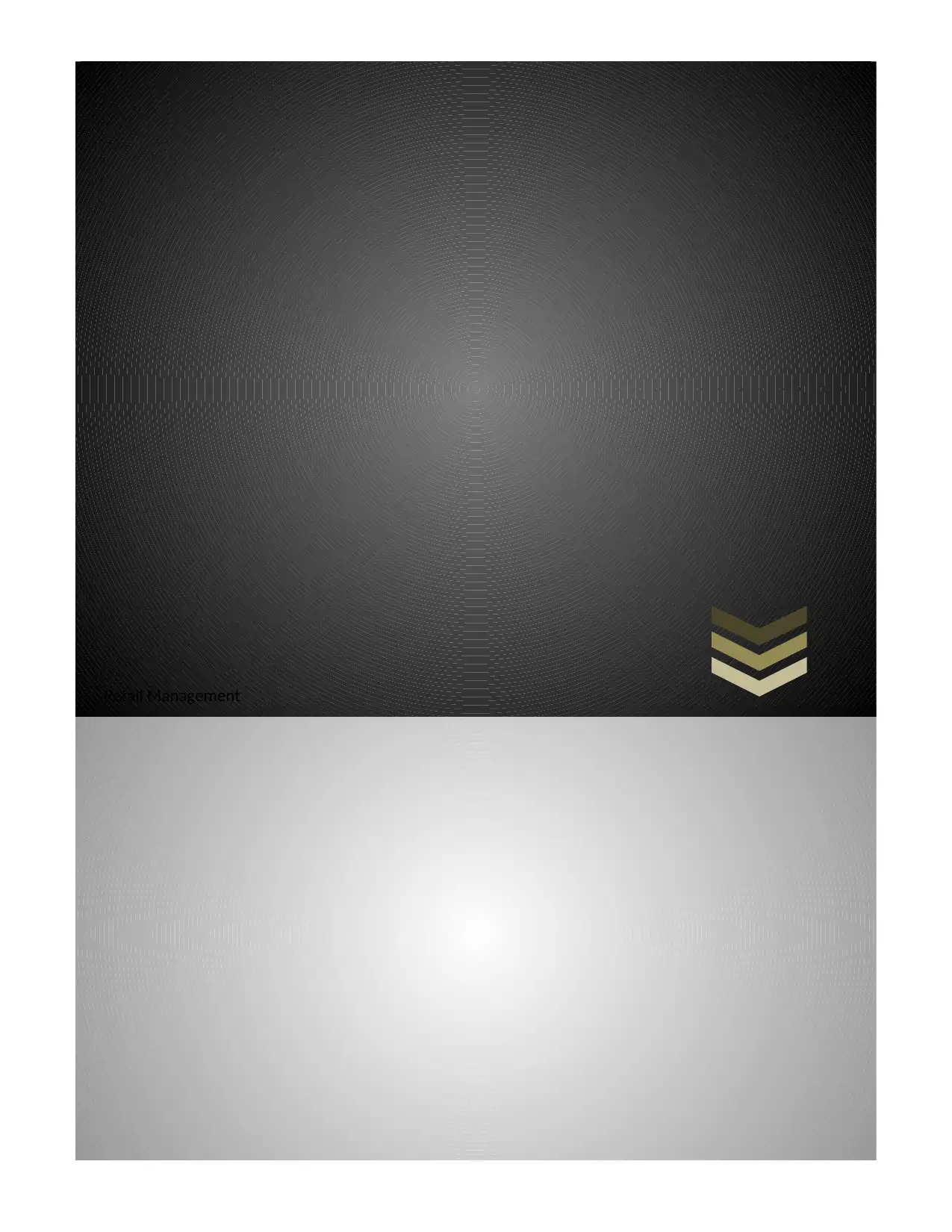
Retail Management
Paraphrase This Document
Need a fresh take? Get an instant paraphrase of this document with our AI Paraphraser

Retail Management 1
Contents
Introduction......................................................................................................................................2
Departmental stores and discount stores......................................................................................2
Wheel of retailing............................................................................................................................3
Retail life cycle................................................................................................................................4
Merchandise carried by retail outlets in Australia...........................................................................5
Market segments of retail stores......................................................................................................6
The change in the face of retail........................................................................................................7
Factors behind the evolution of retail stores....................................................................................8
Future of retailing in 5 years............................................................................................................8
Other types of stores in different market.....................................................................................9
Conclusion.....................................................................................................................................10
References......................................................................................................................................11
Contents
Introduction......................................................................................................................................2
Departmental stores and discount stores......................................................................................2
Wheel of retailing............................................................................................................................3
Retail life cycle................................................................................................................................4
Merchandise carried by retail outlets in Australia...........................................................................5
Market segments of retail stores......................................................................................................6
The change in the face of retail........................................................................................................7
Factors behind the evolution of retail stores....................................................................................8
Future of retailing in 5 years............................................................................................................8
Other types of stores in different market.....................................................................................9
Conclusion.....................................................................................................................................10
References......................................................................................................................................11
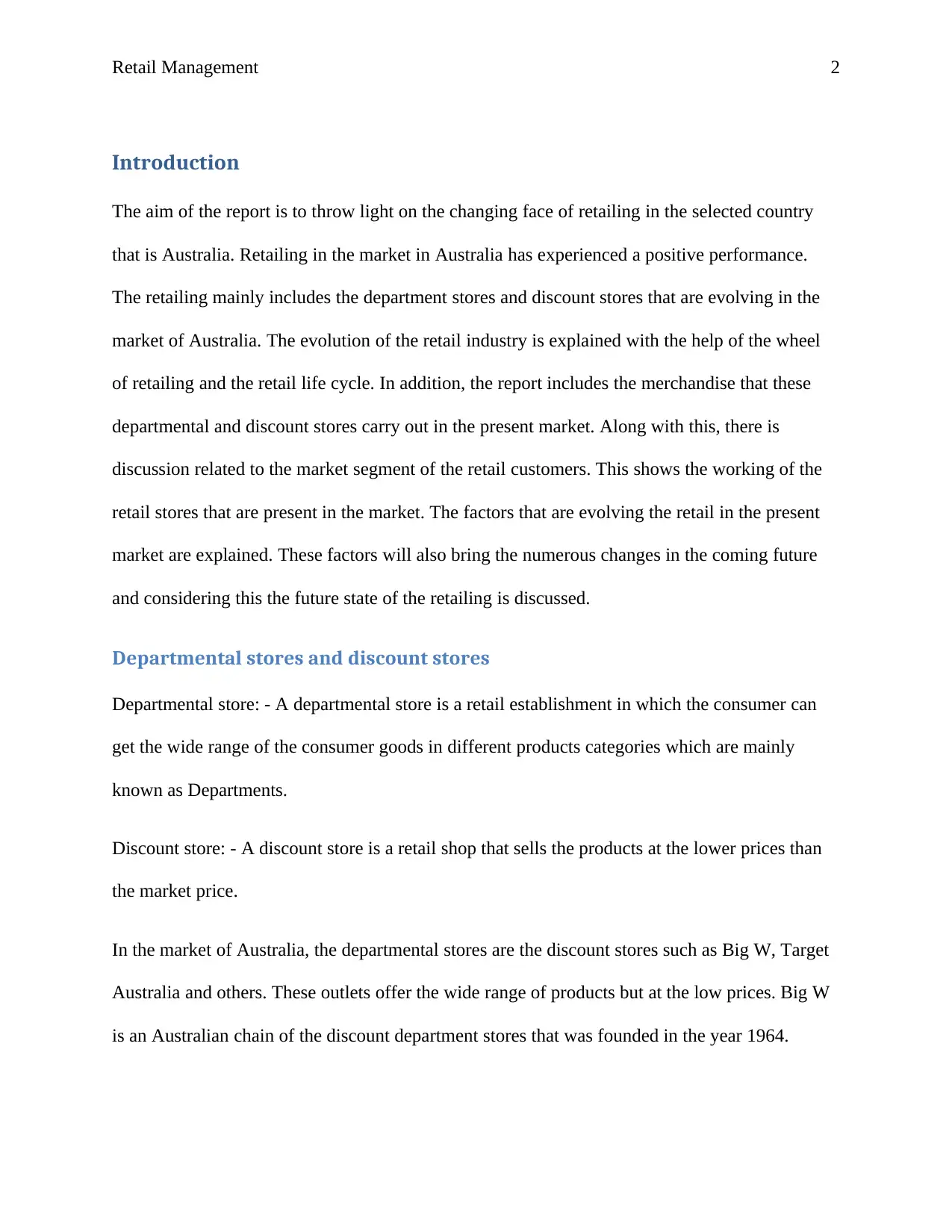
Retail Management 2
Introduction
The aim of the report is to throw light on the changing face of retailing in the selected country
that is Australia. Retailing in the market in Australia has experienced a positive performance.
The retailing mainly includes the department stores and discount stores that are evolving in the
market of Australia. The evolution of the retail industry is explained with the help of the wheel
of retailing and the retail life cycle. In addition, the report includes the merchandise that these
departmental and discount stores carry out in the present market. Along with this, there is
discussion related to the market segment of the retail customers. This shows the working of the
retail stores that are present in the market. The factors that are evolving the retail in the present
market are explained. These factors will also bring the numerous changes in the coming future
and considering this the future state of the retailing is discussed.
Departmental stores and discount stores
Departmental store: - A departmental store is a retail establishment in which the consumer can
get the wide range of the consumer goods in different products categories which are mainly
known as Departments.
Discount store: - A discount store is a retail shop that sells the products at the lower prices than
the market price.
In the market of Australia, the departmental stores are the discount stores such as Big W, Target
Australia and others. These outlets offer the wide range of products but at the low prices. Big W
is an Australian chain of the discount department stores that was founded in the year 1964.
Introduction
The aim of the report is to throw light on the changing face of retailing in the selected country
that is Australia. Retailing in the market in Australia has experienced a positive performance.
The retailing mainly includes the department stores and discount stores that are evolving in the
market of Australia. The evolution of the retail industry is explained with the help of the wheel
of retailing and the retail life cycle. In addition, the report includes the merchandise that these
departmental and discount stores carry out in the present market. Along with this, there is
discussion related to the market segment of the retail customers. This shows the working of the
retail stores that are present in the market. The factors that are evolving the retail in the present
market are explained. These factors will also bring the numerous changes in the coming future
and considering this the future state of the retailing is discussed.
Departmental stores and discount stores
Departmental store: - A departmental store is a retail establishment in which the consumer can
get the wide range of the consumer goods in different products categories which are mainly
known as Departments.
Discount store: - A discount store is a retail shop that sells the products at the lower prices than
the market price.
In the market of Australia, the departmental stores are the discount stores such as Big W, Target
Australia and others. These outlets offer the wide range of products but at the low prices. Big W
is an Australian chain of the discount department stores that was founded in the year 1964.
⊘ This is a preview!⊘
Do you want full access?
Subscribe today to unlock all pages.

Trusted by 1+ million students worldwide
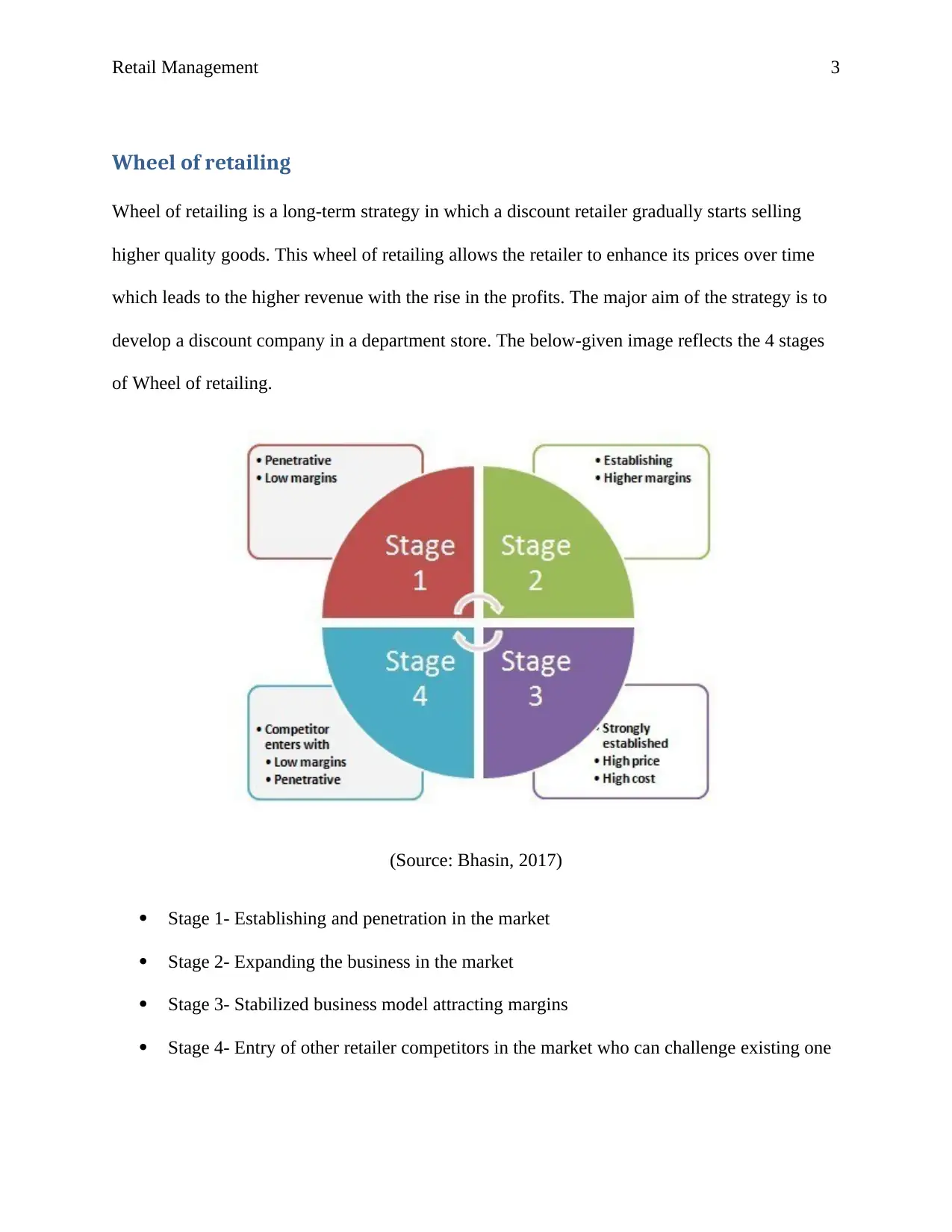
Retail Management 3
Wheel of retailing
Wheel of retailing is a long-term strategy in which a discount retailer gradually starts selling
higher quality goods. This wheel of retailing allows the retailer to enhance its prices over time
which leads to the higher revenue with the rise in the profits. The major aim of the strategy is to
develop a discount company in a department store. The below-given image reflects the 4 stages
of Wheel of retailing.
(Source: Bhasin, 2017)
Stage 1- Establishing and penetration in the market
Stage 2- Expanding the business in the market
Stage 3- Stabilized business model attracting margins
Stage 4- Entry of other retailer competitors in the market who can challenge existing one
Wheel of retailing
Wheel of retailing is a long-term strategy in which a discount retailer gradually starts selling
higher quality goods. This wheel of retailing allows the retailer to enhance its prices over time
which leads to the higher revenue with the rise in the profits. The major aim of the strategy is to
develop a discount company in a department store. The below-given image reflects the 4 stages
of Wheel of retailing.
(Source: Bhasin, 2017)
Stage 1- Establishing and penetration in the market
Stage 2- Expanding the business in the market
Stage 3- Stabilized business model attracting margins
Stage 4- Entry of other retailer competitors in the market who can challenge existing one
Paraphrase This Document
Need a fresh take? Get an instant paraphrase of this document with our AI Paraphraser
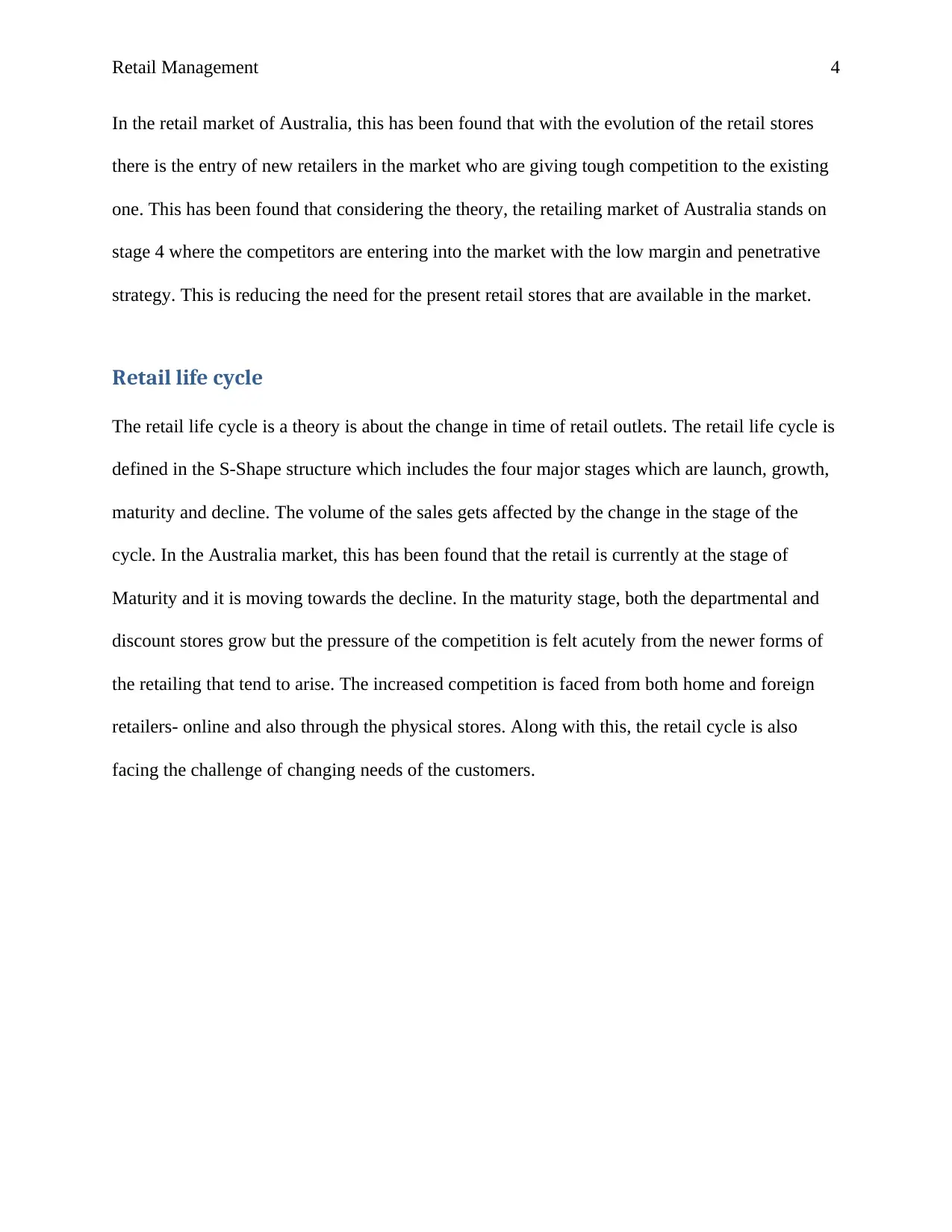
Retail Management 4
In the retail market of Australia, this has been found that with the evolution of the retail stores
there is the entry of new retailers in the market who are giving tough competition to the existing
one. This has been found that considering the theory, the retailing market of Australia stands on
stage 4 where the competitors are entering into the market with the low margin and penetrative
strategy. This is reducing the need for the present retail stores that are available in the market.
Retail life cycle
The retail life cycle is a theory is about the change in time of retail outlets. The retail life cycle is
defined in the S-Shape structure which includes the four major stages which are launch, growth,
maturity and decline. The volume of the sales gets affected by the change in the stage of the
cycle. In the Australia market, this has been found that the retail is currently at the stage of
Maturity and it is moving towards the decline. In the maturity stage, both the departmental and
discount stores grow but the pressure of the competition is felt acutely from the newer forms of
the retailing that tend to arise. The increased competition is faced from both home and foreign
retailers- online and also through the physical stores. Along with this, the retail cycle is also
facing the challenge of changing needs of the customers.
In the retail market of Australia, this has been found that with the evolution of the retail stores
there is the entry of new retailers in the market who are giving tough competition to the existing
one. This has been found that considering the theory, the retailing market of Australia stands on
stage 4 where the competitors are entering into the market with the low margin and penetrative
strategy. This is reducing the need for the present retail stores that are available in the market.
Retail life cycle
The retail life cycle is a theory is about the change in time of retail outlets. The retail life cycle is
defined in the S-Shape structure which includes the four major stages which are launch, growth,
maturity and decline. The volume of the sales gets affected by the change in the stage of the
cycle. In the Australia market, this has been found that the retail is currently at the stage of
Maturity and it is moving towards the decline. In the maturity stage, both the departmental and
discount stores grow but the pressure of the competition is felt acutely from the newer forms of
the retailing that tend to arise. The increased competition is faced from both home and foreign
retailers- online and also through the physical stores. Along with this, the retail cycle is also
facing the challenge of changing needs of the customers.
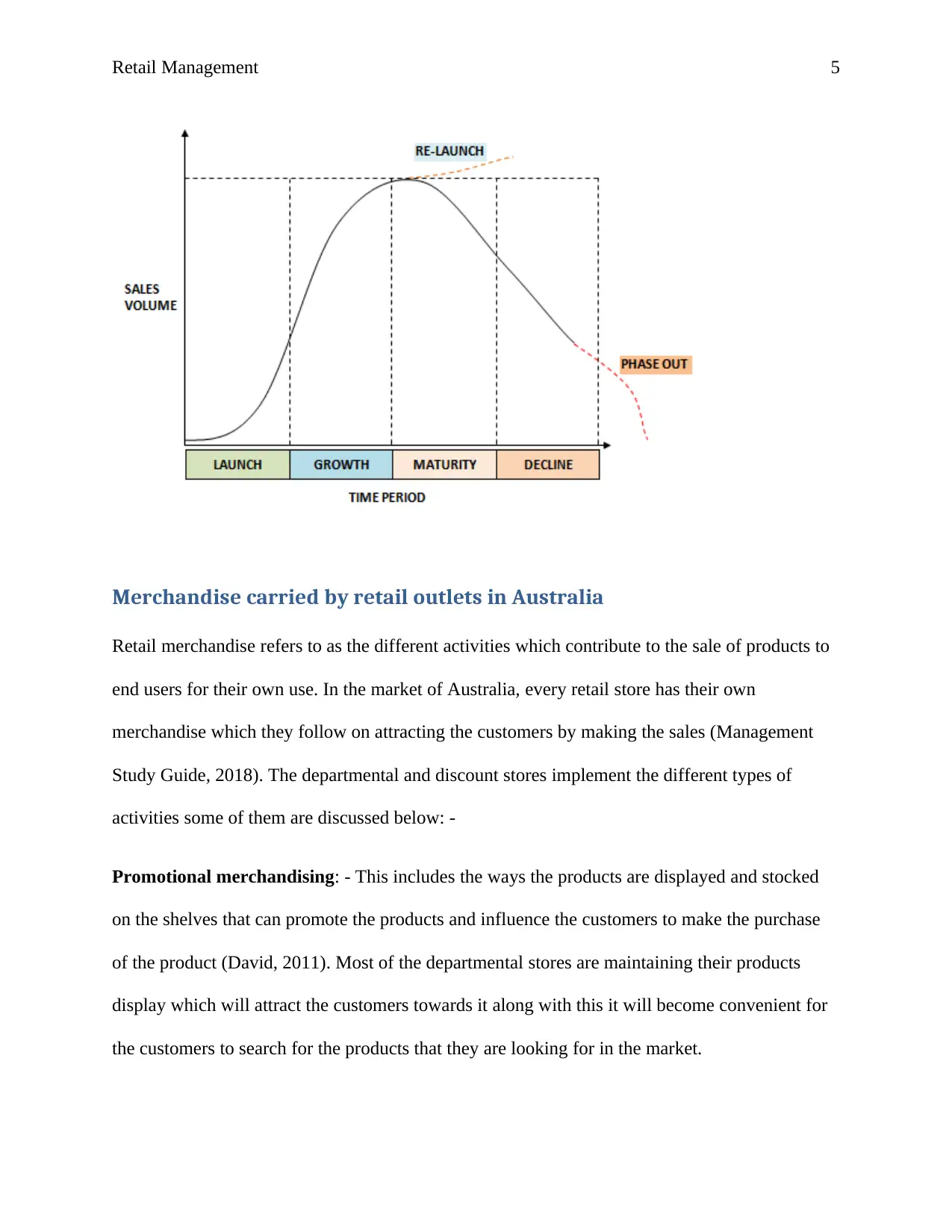
Retail Management 5
Merchandise carried by retail outlets in Australia
Retail merchandise refers to as the different activities which contribute to the sale of products to
end users for their own use. In the market of Australia, every retail store has their own
merchandise which they follow on attracting the customers by making the sales (Management
Study Guide, 2018). The departmental and discount stores implement the different types of
activities some of them are discussed below: -
Promotional merchandising: - This includes the ways the products are displayed and stocked
on the shelves that can promote the products and influence the customers to make the purchase
of the product (David, 2011). Most of the departmental stores are maintaining their products
display which will attract the customers towards it along with this it will become convenient for
the customers to search for the products that they are looking for in the market.
Merchandise carried by retail outlets in Australia
Retail merchandise refers to as the different activities which contribute to the sale of products to
end users for their own use. In the market of Australia, every retail store has their own
merchandise which they follow on attracting the customers by making the sales (Management
Study Guide, 2018). The departmental and discount stores implement the different types of
activities some of them are discussed below: -
Promotional merchandising: - This includes the ways the products are displayed and stocked
on the shelves that can promote the products and influence the customers to make the purchase
of the product (David, 2011). Most of the departmental stores are maintaining their products
display which will attract the customers towards it along with this it will become convenient for
the customers to search for the products that they are looking for in the market.
⊘ This is a preview!⊘
Do you want full access?
Subscribe today to unlock all pages.

Trusted by 1+ million students worldwide
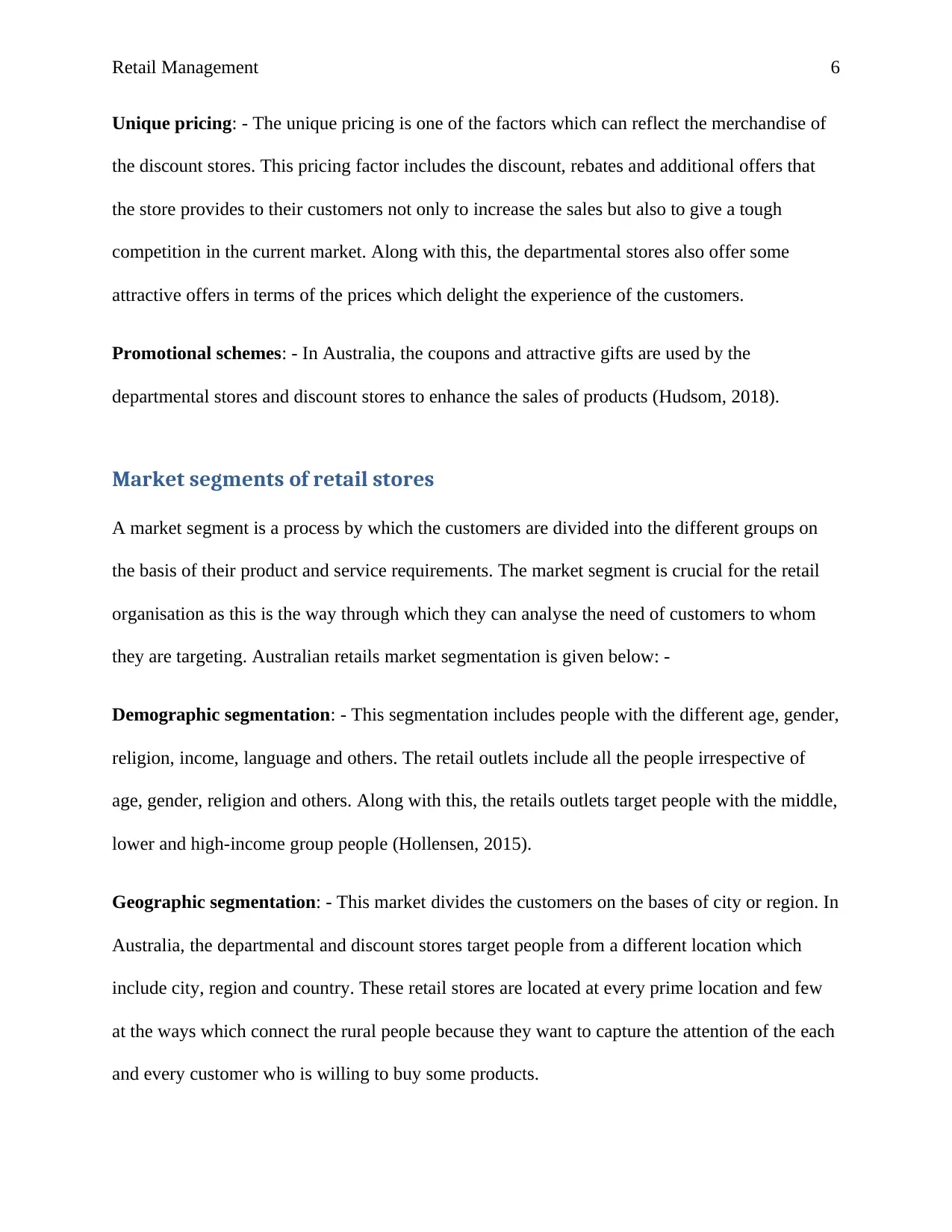
Retail Management 6
Unique pricing: - The unique pricing is one of the factors which can reflect the merchandise of
the discount stores. This pricing factor includes the discount, rebates and additional offers that
the store provides to their customers not only to increase the sales but also to give a tough
competition in the current market. Along with this, the departmental stores also offer some
attractive offers in terms of the prices which delight the experience of the customers.
Promotional schemes: - In Australia, the coupons and attractive gifts are used by the
departmental stores and discount stores to enhance the sales of products (Hudsom, 2018).
Market segments of retail stores
A market segment is a process by which the customers are divided into the different groups on
the basis of their product and service requirements. The market segment is crucial for the retail
organisation as this is the way through which they can analyse the need of customers to whom
they are targeting. Australian retails market segmentation is given below: -
Demographic segmentation: - This segmentation includes people with the different age, gender,
religion, income, language and others. The retail outlets include all the people irrespective of
age, gender, religion and others. Along with this, the retails outlets target people with the middle,
lower and high-income group people (Hollensen, 2015).
Geographic segmentation: - This market divides the customers on the bases of city or region. In
Australia, the departmental and discount stores target people from a different location which
include city, region and country. These retail stores are located at every prime location and few
at the ways which connect the rural people because they want to capture the attention of the each
and every customer who is willing to buy some products.
Unique pricing: - The unique pricing is one of the factors which can reflect the merchandise of
the discount stores. This pricing factor includes the discount, rebates and additional offers that
the store provides to their customers not only to increase the sales but also to give a tough
competition in the current market. Along with this, the departmental stores also offer some
attractive offers in terms of the prices which delight the experience of the customers.
Promotional schemes: - In Australia, the coupons and attractive gifts are used by the
departmental stores and discount stores to enhance the sales of products (Hudsom, 2018).
Market segments of retail stores
A market segment is a process by which the customers are divided into the different groups on
the basis of their product and service requirements. The market segment is crucial for the retail
organisation as this is the way through which they can analyse the need of customers to whom
they are targeting. Australian retails market segmentation is given below: -
Demographic segmentation: - This segmentation includes people with the different age, gender,
religion, income, language and others. The retail outlets include all the people irrespective of
age, gender, religion and others. Along with this, the retails outlets target people with the middle,
lower and high-income group people (Hollensen, 2015).
Geographic segmentation: - This market divides the customers on the bases of city or region. In
Australia, the departmental and discount stores target people from a different location which
include city, region and country. These retail stores are located at every prime location and few
at the ways which connect the rural people because they want to capture the attention of the each
and every customer who is willing to buy some products.
Paraphrase This Document
Need a fresh take? Get an instant paraphrase of this document with our AI Paraphraser

Retail Management 7
Psychographic segmentation: - This segment includes the interests, hobbies, lifestyles, and
other elements (Kotler, 2015). The retail outlets generally target the customers who want all the
products at the low prices with the diverse range of products. In simple words, they search for
the different prices at the store with low cost.
Behavioural segmentation: - This segment divided the customers on the basis of the purchasing
behaviours (Kotler, 2015). In Australia, most of the customers are bringing the changes in their
buying behaviour or patterns. They are shifting from the physical stores to the online stores and
with this, they are becoming price sensitive due to which they always search for the best option
for them.
The change in the face of retail
In the early years, the Australian retail scene in the 20th century was characterised by the high
street retailing and a dominant department store model. After the Second World War, the
evolution of the retailing in Australia started due to the rapid population growth in suburban
areas and the significant rise in the car ownership (Australian Government, 2011). The nature of
the retailing is changing with the change in the environment as the rise of competition and
technology is bringing the changes (Benady, 2014). The retailing in Australia is changing in
response to the rise in the competition which is arising from the popularity of the online
shopping. Advances in the technology with the other retail innovation are adapted according to
the local conditions. The internet has brought the change in the nature of the retail competition as
it invited more and more online companies to offer the products to the different segmented
customers (BT financial, 2018). According to the recent report, the use of the e-commerce by the
customers is increasing in Australia. Online sales in Australia increased from $27 billion in the
Psychographic segmentation: - This segment includes the interests, hobbies, lifestyles, and
other elements (Kotler, 2015). The retail outlets generally target the customers who want all the
products at the low prices with the diverse range of products. In simple words, they search for
the different prices at the store with low cost.
Behavioural segmentation: - This segment divided the customers on the basis of the purchasing
behaviours (Kotler, 2015). In Australia, most of the customers are bringing the changes in their
buying behaviour or patterns. They are shifting from the physical stores to the online stores and
with this, they are becoming price sensitive due to which they always search for the best option
for them.
The change in the face of retail
In the early years, the Australian retail scene in the 20th century was characterised by the high
street retailing and a dominant department store model. After the Second World War, the
evolution of the retailing in Australia started due to the rapid population growth in suburban
areas and the significant rise in the car ownership (Australian Government, 2011). The nature of
the retailing is changing with the change in the environment as the rise of competition and
technology is bringing the changes (Benady, 2014). The retailing in Australia is changing in
response to the rise in the competition which is arising from the popularity of the online
shopping. Advances in the technology with the other retail innovation are adapted according to
the local conditions. The internet has brought the change in the nature of the retail competition as
it invited more and more online companies to offer the products to the different segmented
customers (BT financial, 2018). According to the recent report, the use of the e-commerce by the
customers is increasing in Australia. Online sales in Australia increased from $27 billion in the
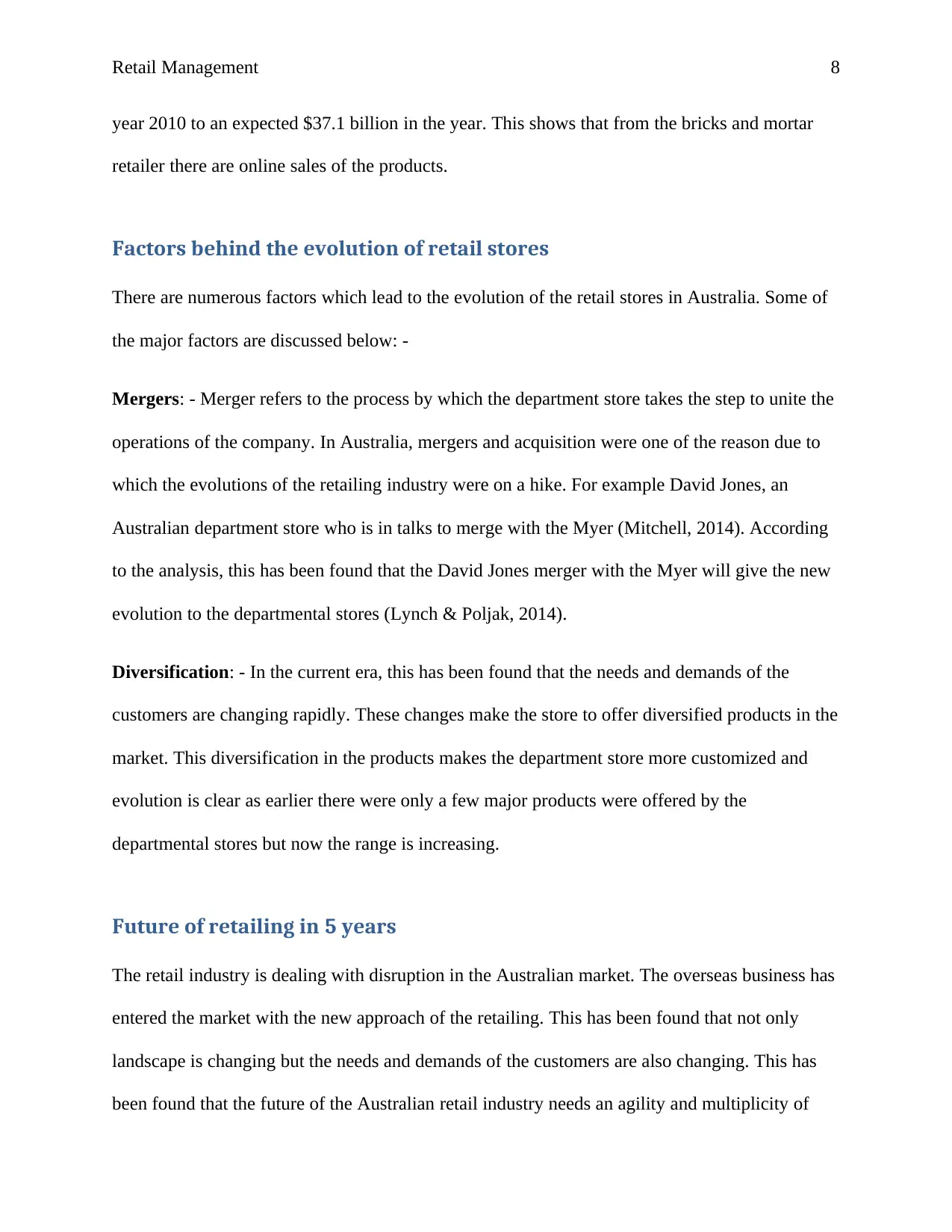
Retail Management 8
year 2010 to an expected $37.1 billion in the year. This shows that from the bricks and mortar
retailer there are online sales of the products.
Factors behind the evolution of retail stores
There are numerous factors which lead to the evolution of the retail stores in Australia. Some of
the major factors are discussed below: -
Mergers: - Merger refers to the process by which the department store takes the step to unite the
operations of the company. In Australia, mergers and acquisition were one of the reason due to
which the evolutions of the retailing industry were on a hike. For example David Jones, an
Australian department store who is in talks to merge with the Myer (Mitchell, 2014). According
to the analysis, this has been found that the David Jones merger with the Myer will give the new
evolution to the departmental stores (Lynch & Poljak, 2014).
Diversification: - In the current era, this has been found that the needs and demands of the
customers are changing rapidly. These changes make the store to offer diversified products in the
market. This diversification in the products makes the department store more customized and
evolution is clear as earlier there were only a few major products were offered by the
departmental stores but now the range is increasing.
Future of retailing in 5 years
The retail industry is dealing with disruption in the Australian market. The overseas business has
entered the market with the new approach of the retailing. This has been found that not only
landscape is changing but the needs and demands of the customers are also changing. This has
been found that the future of the Australian retail industry needs an agility and multiplicity of
year 2010 to an expected $37.1 billion in the year. This shows that from the bricks and mortar
retailer there are online sales of the products.
Factors behind the evolution of retail stores
There are numerous factors which lead to the evolution of the retail stores in Australia. Some of
the major factors are discussed below: -
Mergers: - Merger refers to the process by which the department store takes the step to unite the
operations of the company. In Australia, mergers and acquisition were one of the reason due to
which the evolutions of the retailing industry were on a hike. For example David Jones, an
Australian department store who is in talks to merge with the Myer (Mitchell, 2014). According
to the analysis, this has been found that the David Jones merger with the Myer will give the new
evolution to the departmental stores (Lynch & Poljak, 2014).
Diversification: - In the current era, this has been found that the needs and demands of the
customers are changing rapidly. These changes make the store to offer diversified products in the
market. This diversification in the products makes the department store more customized and
evolution is clear as earlier there were only a few major products were offered by the
departmental stores but now the range is increasing.
Future of retailing in 5 years
The retail industry is dealing with disruption in the Australian market. The overseas business has
entered the market with the new approach of the retailing. This has been found that not only
landscape is changing but the needs and demands of the customers are also changing. This has
been found that the future of the Australian retail industry needs an agility and multiplicity of
⊘ This is a preview!⊘
Do you want full access?
Subscribe today to unlock all pages.

Trusted by 1+ million students worldwide
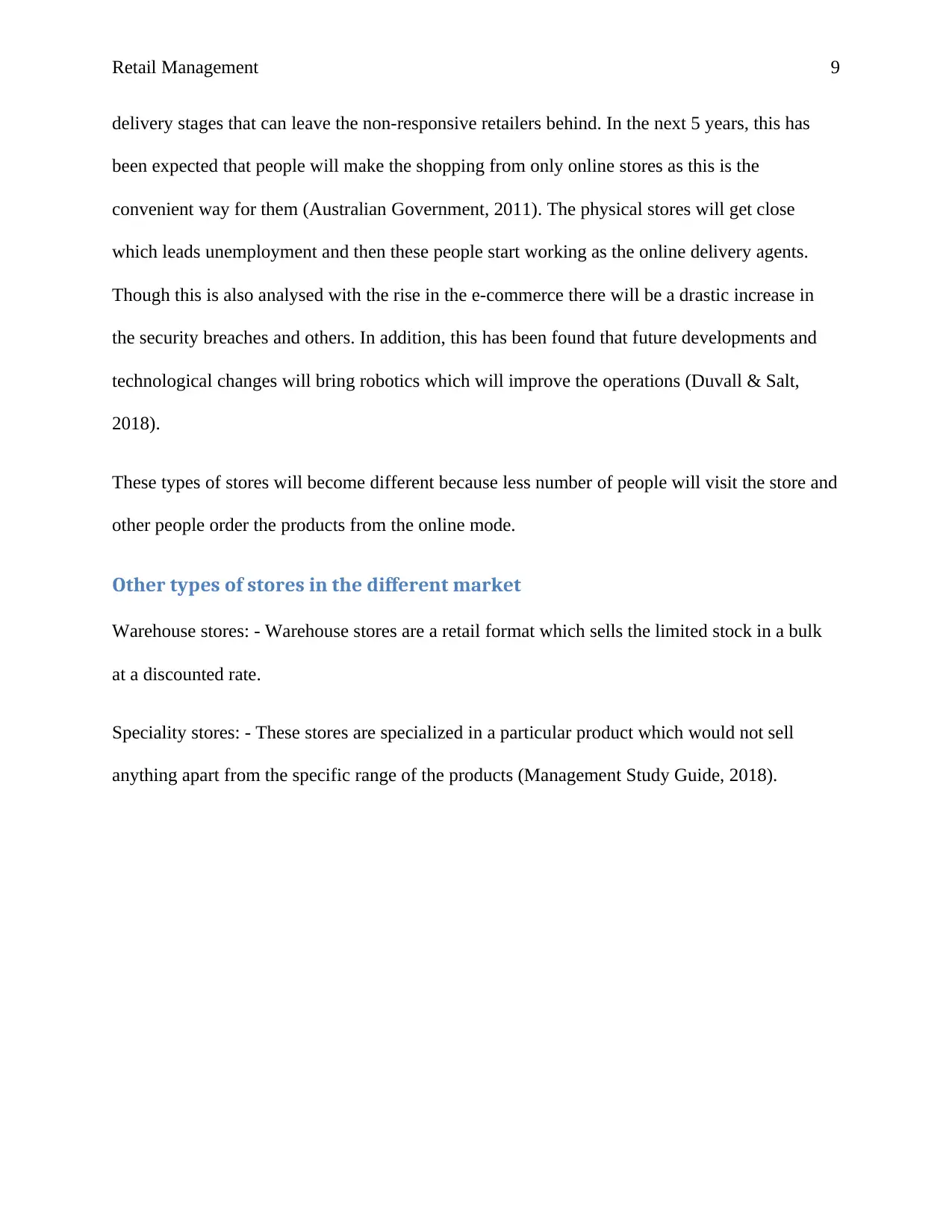
Retail Management 9
delivery stages that can leave the non-responsive retailers behind. In the next 5 years, this has
been expected that people will make the shopping from only online stores as this is the
convenient way for them (Australian Government, 2011). The physical stores will get close
which leads unemployment and then these people start working as the online delivery agents.
Though this is also analysed with the rise in the e-commerce there will be a drastic increase in
the security breaches and others. In addition, this has been found that future developments and
technological changes will bring robotics which will improve the operations (Duvall & Salt,
2018).
These types of stores will become different because less number of people will visit the store and
other people order the products from the online mode.
Other types of stores in the different market
Warehouse stores: - Warehouse stores are a retail format which sells the limited stock in a bulk
at a discounted rate.
Speciality stores: - These stores are specialized in a particular product which would not sell
anything apart from the specific range of the products (Management Study Guide, 2018).
delivery stages that can leave the non-responsive retailers behind. In the next 5 years, this has
been expected that people will make the shopping from only online stores as this is the
convenient way for them (Australian Government, 2011). The physical stores will get close
which leads unemployment and then these people start working as the online delivery agents.
Though this is also analysed with the rise in the e-commerce there will be a drastic increase in
the security breaches and others. In addition, this has been found that future developments and
technological changes will bring robotics which will improve the operations (Duvall & Salt,
2018).
These types of stores will become different because less number of people will visit the store and
other people order the products from the online mode.
Other types of stores in the different market
Warehouse stores: - Warehouse stores are a retail format which sells the limited stock in a bulk
at a discounted rate.
Speciality stores: - These stores are specialized in a particular product which would not sell
anything apart from the specific range of the products (Management Study Guide, 2018).
Paraphrase This Document
Need a fresh take? Get an instant paraphrase of this document with our AI Paraphraser
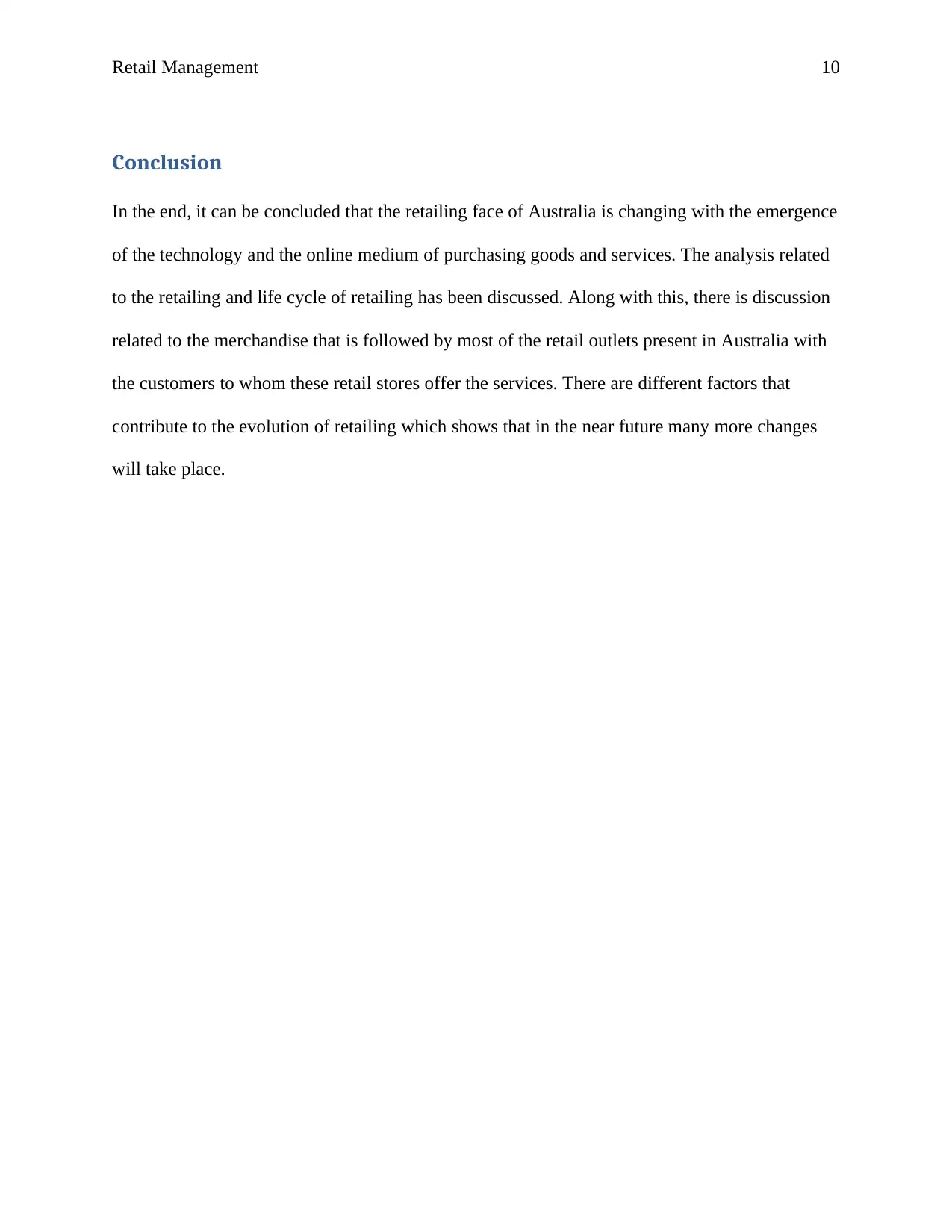
Retail Management 10
Conclusion
In the end, it can be concluded that the retailing face of Australia is changing with the emergence
of the technology and the online medium of purchasing goods and services. The analysis related
to the retailing and life cycle of retailing has been discussed. Along with this, there is discussion
related to the merchandise that is followed by most of the retail outlets present in Australia with
the customers to whom these retail stores offer the services. There are different factors that
contribute to the evolution of retailing which shows that in the near future many more changes
will take place.
Conclusion
In the end, it can be concluded that the retailing face of Australia is changing with the emergence
of the technology and the online medium of purchasing goods and services. The analysis related
to the retailing and life cycle of retailing has been discussed. Along with this, there is discussion
related to the merchandise that is followed by most of the retail outlets present in Australia with
the customers to whom these retail stores offer the services. There are different factors that
contribute to the evolution of retailing which shows that in the near future many more changes
will take place.

Retail Management 11
References
Australian Government. (2011). Economic Structure and Performance of the Australian Retail
Industry. Retrieved from:
https://www.pc.gov.au/inquiries/completed/retail-industry/report/retail-industry.pdf
Benady, D. (2014). Brands, technology and the changing face of retail. Retrieved from:
https://www.theguardian.com/media-network/media-network-blog/2014/mar/03/brands-
technology-changing-face-retail
Bhasin, H. (2017). The Wheel of retailing concept. Retrieved from:
https://www.marketing91.com/the-wheel-of-retailing-concept/
BT financial. (2018). Competition for the Australian retail sector may bring upside. Retrieved
from: https://www.bt.com.au/insights/perspectives/2018/02/competition-for-Australian-
retail.html
David, F.R. (2011). Strategic management: Concepts and cases. India: Pearson/Prentice Hall.
Duvall, T. & Salt, B. (2018). Future of retail in Australia. Retrieved from:
https://home.kpmg.com/au/en/home/insights/2018/04/bernard-salt-next-5-years-retail-
future-australia.html
Hollensen, S. (2015). Marketing management: A relationship approach. India: Pearson
Education Limited.
References
Australian Government. (2011). Economic Structure and Performance of the Australian Retail
Industry. Retrieved from:
https://www.pc.gov.au/inquiries/completed/retail-industry/report/retail-industry.pdf
Benady, D. (2014). Brands, technology and the changing face of retail. Retrieved from:
https://www.theguardian.com/media-network/media-network-blog/2014/mar/03/brands-
technology-changing-face-retail
Bhasin, H. (2017). The Wheel of retailing concept. Retrieved from:
https://www.marketing91.com/the-wheel-of-retailing-concept/
BT financial. (2018). Competition for the Australian retail sector may bring upside. Retrieved
from: https://www.bt.com.au/insights/perspectives/2018/02/competition-for-Australian-
retail.html
David, F.R. (2011). Strategic management: Concepts and cases. India: Pearson/Prentice Hall.
Duvall, T. & Salt, B. (2018). Future of retail in Australia. Retrieved from:
https://home.kpmg.com/au/en/home/insights/2018/04/bernard-salt-next-5-years-retail-
future-australia.html
Hollensen, S. (2015). Marketing management: A relationship approach. India: Pearson
Education Limited.
⊘ This is a preview!⊘
Do you want full access?
Subscribe today to unlock all pages.

Trusted by 1+ million students worldwide
1 out of 13
Related Documents
Your All-in-One AI-Powered Toolkit for Academic Success.
+13062052269
info@desklib.com
Available 24*7 on WhatsApp / Email
![[object Object]](/_next/static/media/star-bottom.7253800d.svg)
Unlock your academic potential
Copyright © 2020–2026 A2Z Services. All Rights Reserved. Developed and managed by ZUCOL.




